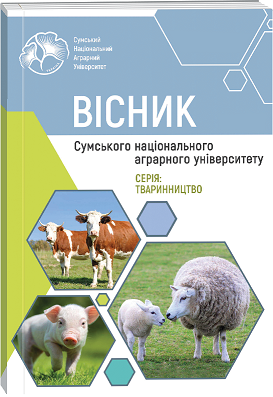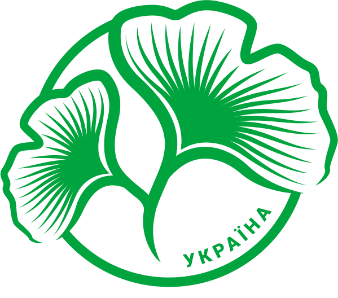MODELING OF THE COMPONENTS OF LIVE WEIGHT CURVES OF HENS
Abstract
The article presents the results of descriptive modeling of the polygenically determined quantitative trait «live weight» on a wide genetic material of chickens of different genotypes, obtained during an experiment to study the effectiveness of crossing imported meat crosses with meat-and-egg females of domestic selection. In general, it can be noted that the mathematical models used by B. Gompertz, T. Bridges, F. Richards made it possible to fairly adequately describe the dynamics of increasing the live weight of chickens of different genotypes. The average percentage of deviations of the actual values of live weight from the theoretically calculated ones according to the B. Gompertz model ranged within 1.73–8.36%. The smallest discrepancies were determined in chickens of the improved subpopulation “K-5», the largest ones in birds F11 of the subpopulation “K». With the smallest discrepancy from the actually determined values, the B. Gompertz model described the live weight at the end of chicken rearing – at 10 weeks. When using the T. Bridges model, in the vast majority of the studied groups of chickens, a significant underestimation of live weight indicators at the 2nd week of life was noted – by 11.17–24.76% compared to the actual ones. Also, this model in all groups of poultry slightly overestimated the live weight at the 8th week (by 3.95–15.70%). In general, the average percentage of deviation between the actually obtained live weight indicators and the theoretically calculated ones was 1.59–8.34%. In chickens of the synthetic population «K-5», the maximum accuracy of the description of the dynamics of the live weight of chickens in early ontogenesis was obtained. The model of F. Richards, similar to the model of T. Bridges, in most groups underestimated the values of live weight at the 2nd week. This is especially clearly observed in meat-egg chickens F11 and offspring F2 – the deviations of empirical values from the actual ones are significant (13.67–20.81%). Also, the F. Richards model overestimated the live weight at the 8th week of chicken life by 3.91–13.15%. Like the previous two models, this model described with high accuracy the dynamics of the live weight of chickens during 10 weeks of growing in the synthetic population «K-5». The discrepancies between the actual and theoretically determined by the model live weight values are minimal – only 1.78%.
References
2. Faraji-Arough, Hadi, Ghazaghi, Mahmoud, & Rokouei, Mohammad. (2023). Mathematical Modeling of Egg Production Curve in Khazak Indigenous Hens. Poultry Science Journal, 11(1), 73–81. doi: 10.22069/psj.2022.20251.1820.
3. Ferreira, N.T., Nilva, K., & Sakomura, N.K. (2015). Modelling the egg components and laying patterns of broiler breeder hens. Animal Production Science, 78(10), 342–360. dx.doi.org/10.1071/AN1437.
4. Ganesan, R., Dhanavanthan, P., & Sreenivasaiah, P. V. (2011). Comparative study of non-linear models for describing poultry egg production in Puducherry. Current Biotica, 5(3), 289–298.
5. Gompertz, B. (1925). On the nature of the function expressive of the law of human mortality, and a new mode of determining the value of live contingencies. Phil. Trans. Roy. Soc, 82, 513–585.
6. Javid, I., Sohai, H.K., & Nasir, M. (2016). Effects of egg size (weight) and age on hatching performance and chick quality of broiler breeder. J. Appl. Anim. Res., 44, 354–364.
7. Kovalenko, I. I. (2003). Vikoristannya matematichnih modelej dlya ocinki parametriv rostu ptici riznih klasiv rozpodilu [The use of mathematical models to estimate the growth parameters of poultry of different classes of distribution]. Tavria Scientific Bulletin, 22, 96–99. (in Ukrainian).
8. Khvostyk, V. P., & Bondarenko, Yu. V. (2021). Selektsiino-henetychni pidkhody do vyvedennia novykh henotypiv dymorfnykh husei [Selection and genetic approaches to the development of new genotypes of dimorphic geese]. Bulletin of the Sumy NAU. “Livestock” series, 2(45), 47–53. DOI: 10.32845/bsnau.lvst.2021.2.7. (in Ukrainian).
9. Leksrisompong, N., Romero-Sanchez, H., & Oviedo-Rondón, E.O. (2014). Effects of feeder space allocations during rearing, female strain, and feed increase rate from photo stimulation to peak egg production on broiler breeder female performance. Poultry Sci., 93, 1045–1052.
10. Leshchyshyn, I. S., & Kyryliv, Ya. I. (2021). The indicators of meat productivity of the ducklings of the Beijing and Cherry Valley crosses during growing with the use of Activio supplement. Peredhirne ta hirske zemlerobstvo i tvarynnytstvo, 69(2), 165–179. doi: 10.32636/01308521.2021-(69)-2-11 .
11. Lihare, G. O., Wasike, C. B., & Kahi, A. K. (2020). Describing Growth Pattern Using Gompertz Growth Function – A Case Study of Kuchi Chicken in Kenya. Poultry Science Journal, 8(2), 119–127. doi: 10.22069/psj.2020.18194.1606.
12. Mohammad, Aziz Sharifi, Chandrashekhar, Santosh Patil, Abhay, Singh Yadav, & Yogesh, Chandrakant Bangar (2022). Mathematical modeling for egg production and egg weight curves in a synthetic white leghorn. Poultry Science, 101(4), 101766. doi: 10.1016/j.psj.2022.101766.
13. Narinc, D., Uckardes, F., & Aslan, E. (2014). Egg production curve analysis in poultry science. World Poultry Sci. J., 70, 817–828.
14. Otwinowska-Mindur, A., Gumułka, M., & Kania-Gierdziewicz, J. (2016). Mathematical models for egg production in broiler breeder hens. Ann. Anim. Sci., 16(4), 1185–1198. doi: 10.1515/aoas-2016-0037.
15. Richards, F. J. (1959). A flexible growth function for empirical use. Journal of experimental Botany, 10, 290–300.
16. Savegnago, R. P., Cruz, V. A. R., & Ramos, S. B. (2012). Egg production curve fitting using nonlinear models for selected and nonselected lines of White Leghorn hens. Poultry Science, 91(11), 2977–2987. doi: 10.3382/ps.2012-02277.
17. Stepanenko, N. V. (2020). Doslidzhennya pokaznikiv efektivnosti virobnictva yayec za dopomogoyu matematichnih metodiv ta modelej [Research of the performance indicators of egg production by mathematical methods and models]. Tavria Scientific Bulletin. Series “Economics”, 2, 303–312. doi: 10.32851/2708-0366/2020.2.38. (in Ukrainian).
18. Wencek, E., Kałużna, I., & Koźlecka, M. (2015). Performance assessment of the utilitarian and breeding values of meat-type hens. The results of the assessment of the utilitarian value of poultry in 2014 (in Polish). The National Poultry Council – Chamber of Commerce, Warsaw, 1243–1387.
19. Wolc, A., Graczyk, M., & Settar, P. (2015). Modified Wilmink curve for egg production analysis in layers. XXVII International Poultry Science Symposium PB WPSA “Science to practice – practice to science”, Bydgoszcz, Poland, 56.

 ISSN
ISSN  ISSN
ISSN 



